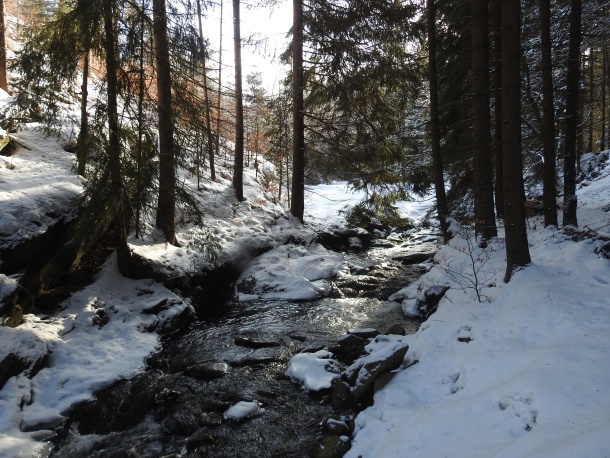Registration №
100305303
Funding
ERDF (European Regional Development Fund)
Programme to promote cross-border cooperation between the Czech Republic and the Free State of Saxony 2014-2020

Date
–
Partners
AG Naturschutzinstitut Region Dresden eV (Lead Partner)
Contact
Kateřina Poledníková
Target species
Eurasian otter
Target area
Krušné hory
Countries
Czechia, Germany
Introduction
The Eurasian Otter is a predator whose population status is increasing in the Czech Republic after decades of decline. Firstly, for species success, otters need a healthy aquatic ecosystem. Clean water, fish in the streams, amphibians in the pools, and vegetation along the banks to keep them hidden are all features required for habitat they live in. Secondly, they need enough of this type of habitat to sustain the whole population. They have a relatively large territory and for the population to function, there needs to be enough habitat available so individuals can communicate with their neighbours, without too much conflict and so young animals can travel and find their own territories. These requirements put an increased pressure on the species, to find interconnected areas without significant barriers which might force them onto roads or to urban areas.
This information has led us to the following questions:
- What is the status of the otter in the Ore Mountains and the adjacent foothills?
- Are the streams in the Ore Mountains only home to isolated otter populations or does the otter migrate from Bohemia to Saxony?
- If they are connected, where are these connections? Are they from mountain streams down to the main streams of the Ohře and Elbe?
- From which populations did the otter return to the Ore Mountains from? South Bohemia or neighbouring Saxony?
- What risks factors are influencing their future survival?
- Is it possible to adjust these risk factors to ensure a better future for these otters?
- If so, who can do that?
We would like to answer these questions within the Lutra lutra project.
Objectives of the project
- Identification of migration corridors between Czech and Saxon otter subpopulations
- Identification of migration barriers and risk spots
- Development, design and implementation of risk elimination measures
- Creating a database for population analysis
- Strengthening the cooperation between partners from both countries
- Further education and information for the professional and general public

Project activities
Monitoring
Detailed monitoring of the occurrence of the Eurasian otter in the target area will be carried out. The target area is a catchment area of the cross-border rivers Sapava (Zschopau) and its tributaries Polava and Přísečnice, Moldava (Freiberger Mulde) with tributaries and Divoká Bystřice (Wilde Weißeritz), the upper catchment area of the Flájský brook with tributaries Černá , Świdnica, Načetínský potok and streams draining water from the Ore Mountains towards Ohře and Labe: Prunéřovský potok, Chumutovka, Bílina, Kundratický stream, Bouřlivec and Bystřice.
ASSESSMENT OF ENVIRONMENTAL POTENTIAL
Individual streams and other bodies of water such as ponds will be assessed for their potential for otters and their prey animals.
Genetic study
Genetic samples are to be taken from potential source populations (Saxon and South Bohemian) and will be compared with samples obtained from the target area. The project aims to determine the current genetic status of the individuals now living in the target area, the relationship between subpopulations and any interconnections between populations.
IDENTIFICATION OF MIGRATION CORRIDORS AND ANALYSIS OF RISK POINTS
On the basis of preliminary analyses, a total of five areas were identified where otters can cross the river basin/border by land: Vejprt, Hora Sv. Šebestiána, Hora Sv. Kateřiny, Český Jiřetín and Moldava. The project aims to collect otter samples in the snow to identify cross-border migration routes. In addition, the project aims to identify migration routes along the streams and the places in which otter migration may be more difficult such as poorly designed bridges, channels, improperly modified flows in urban areas, etc.
PROPOSALS FOR MEASURES TO PROTECT THE OTTER
Measures to eliminate, or at least mitigate, risk factors will be proposed based on the information collected in the project. Following this, a solution based proposal will be presented for high-risk places on the road in an attempt to allow the otter to pass safely.
FURTHER INFORMATION AND PUBLIC AWARENESS
In order to reduce conflict, an awareness campaign will take place. An information publication will be prepared for fisherman and others who use known fishing areas. Fisheries and other relevant partners will be contacted to ensure a stable environment for the otters.
News
Northern raccoon in Krušné Hory
Starting otter research in Krušné Hory
About the project in local media
Interview with Václav Beran on Czech Radio (Radio show: Planetárium, aired 28.4.2018 18:10)
Scientists look for a way to the Ohře for German otters (idnes.cz, 18.12.2017)

